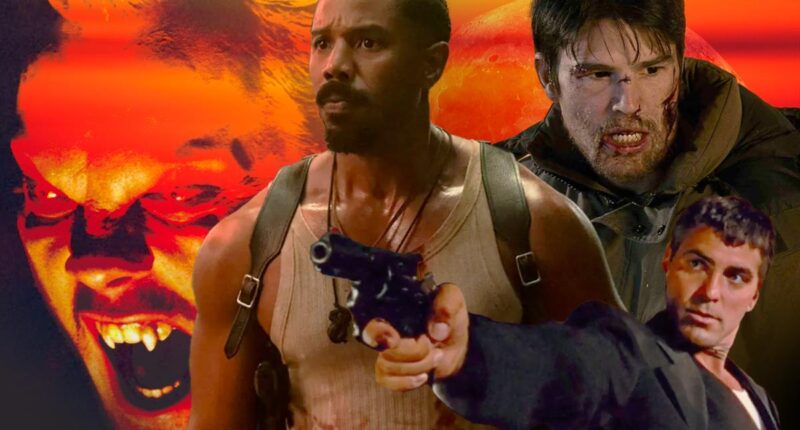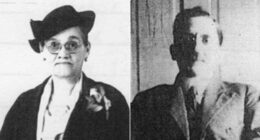Ryan Coogler’s latest film Sinners takes place in 1932, a time when characters like twin brothers known as Smoke and Stack, portrayed by Michael B. Jordan, might have had an opportunity to watch the movie Dracula released the year before. It’s uncertain if Smoke and Stack could have spared time from their work for Chicago gangsters to attend a movie, but considering that John Dillinger met his demise just outside a movie theater a couple of years later, anything is possible. When Smoke and Stack come face to face with a group of vampires later in the movie, it’s Smoke’s former flame Annie, played by Wunmi Mosaku, who is more knowledgeable about vampire lore involving sunlight, stakes to the heart, and possibly garlic.
The vampires that make an appearance at the juke joint in Sinners may have a leader, but they come across as a unified collective – a hive mind eager to claim more souls, advocating for a form of equality among the damned. These vampires are depicted more as an organized army rather than the alluring solitude commonly associated with Dracula and similar adaptations like Nosferatu. Unlike those vampires whose main goal is to drain their victims, with turning them being a secondary concern, Sinners follows a different narrative tradition, focusing on a vampire siege scenario.
In a way, the vampire siege theme can be seen as a practical response to the challenge of surpassing the iconic status of Dracula or maintaining fear around a Dracula-like character after numerous interpretations have graced the screens over the years. Unlike characters like the Wolf Man or the Invisible Man, who became his adversaries in the Universal Monsters series from the 1930s to the 1950s, Dracula is an individual figure, his identity forever interlinked with his monstrous nature. While the Wolf Man in the Universal series is often portrayed as Lawrence Talbot, it’s worth noting that Talbot isn’t the definitive representation of werewolves, nor was he the first werewolf character featured by the studio; Universal had a werewolf-themed movie titled Werewolf of London before The Wolf Man, whereas non-Dracula vampire films weren’t as prevalent in Universal’s catalog. For a long time, even as vampire characters diversified beyond Dracula, he remained preeminent in terms of iconic stature.
The idea of a whole mess of vampires, rather than a figure of singular, Drac-like evil, seemed to gain more traction in the wake of George Romero’s zombie movies, which often feature human beings holed up in a western-style outpost. It stands to reason that vampires would make stronger opponents for this kind of stand-off; zombies may be relentless and inexorable, but they also can’t really strategize. Vampires, on the other hand, can be crafty in groups, a differently shaped form of manipulation than the solo Dracula model. The Stephen King book Salem’s Lot (adapted into a TV miniseries as well as a recent, quite bad feature version) uses a vampire collective, and The Lost Boys riffs on that a bit with its teenage vamp gang and “head vampire.”

But a pair of later vampire movies took the vampire siege closer to Assault on Precinct 13 territory, and feel like a stronger influence on what Sinners is up to, at least logistically. 30 Days of Night, from 2007, has elements of both zombie movies and alien movies, forcing a group of humans to contend with vamps who invite a small Alaskan town embarking on a thirty-day period without a sunrise. (The vampires are sort of like the aliens in Pitch Black, which themselves are knocked off from Aliens.) Even closer to Sinners is From Dusk Till Dawn, a Robert Rodriguez/Quentin Tarantino where a pair of criminal brothers happen upon a Mexican roadhouse that’s secretly a vampire-run trap for unwitting truckers and travelers. As in Sinners, a small group of humans with their backs to the wall must try to survive the night.
Sinners takes the vampire-siege movie in a new direction by emphasizing the cultural togetherness that the vampires encroach upon. In a non-monster movie like John Carpenter’s Assault on Precinct 13, the bad guys are attacking a government-sanctioned facility; in Dawn of the Dead, backing humanity into mall survival functions as a dark joke, practically a ritual humiliation. In From Dusk Till Dawn, fair play or not, it’s the vamps’ territory that humans stumble into. Even 30 Days of Night, while technically an invasion, involves a perfect vampire feeding ground. The juke joint in Sinners, though, has just been spruced up and reclaimed for the Black community. Though the vampires are specifically not a one-to-one analog to a Ku Klux Klan type of hate group—the Klan rears its ugly head separately—they’re definitely encroaching on another group’s Jim Crow-era attempt to establish space for themselves.

And unlike Dracula-style vampire stories, vampire-siege movies place more emphasis on the zombie-like “turning” of victims, recruiting them into an undead army that’s typically more purposeful than the shuffling, mindless zombie masses. That factor makes Sinners more thought-provoking than a simple white-vampires-versus-Black-humans allegory; the movie feels like it’s addressing the knotty idea of American assimilation, while past vampire-related allegories have treated them (quite imperfectly) as aligned with minority groups, rather than a multiracial coalition.
Without giving too much away, Sinners also utilizes a typical vampire-siege reversal of the attempt to defeat evil. In many versions of Dracula, a group of men band together and combine forces in an attempt to stop him; movies about vampire groups almost always amount to the many making underdogs of the few, with the standard gathering of makeshift weapons. Even as they try to puff themselves up into vampire hunters, the humans are unavoidably the hunted, and the best strategy is to outlast, rather than out-muscle. Sinners makes that resilience part of its historical context. Almost inevitably, vampire-siege movies end with at least a few survivors; Coogler uses those slim odds to illustrate a grim and less supernatural form of miracle.
Jesse Hassenger (@rockmarooned) is a writer living in Brooklyn podcasting at www.sportsalcohol.com. He’s a regular contributor to The A.V. Club, Polygon, and The Week, among others.
(function(d, s, id) {
var js, fjs = d.getElementsByTagName(s)[0];
if (d.getElementById(id)) return;
js = d.createElement(s); js.id = id;
js.src = “//connect.facebook.net/en_US/sdk.js#xfbml=1&appId=823934954307605&version=v2.8”;
fjs.parentNode.insertBefore(js, fjs);
}(document, ‘script’, ‘facebook-jssdk’));

















